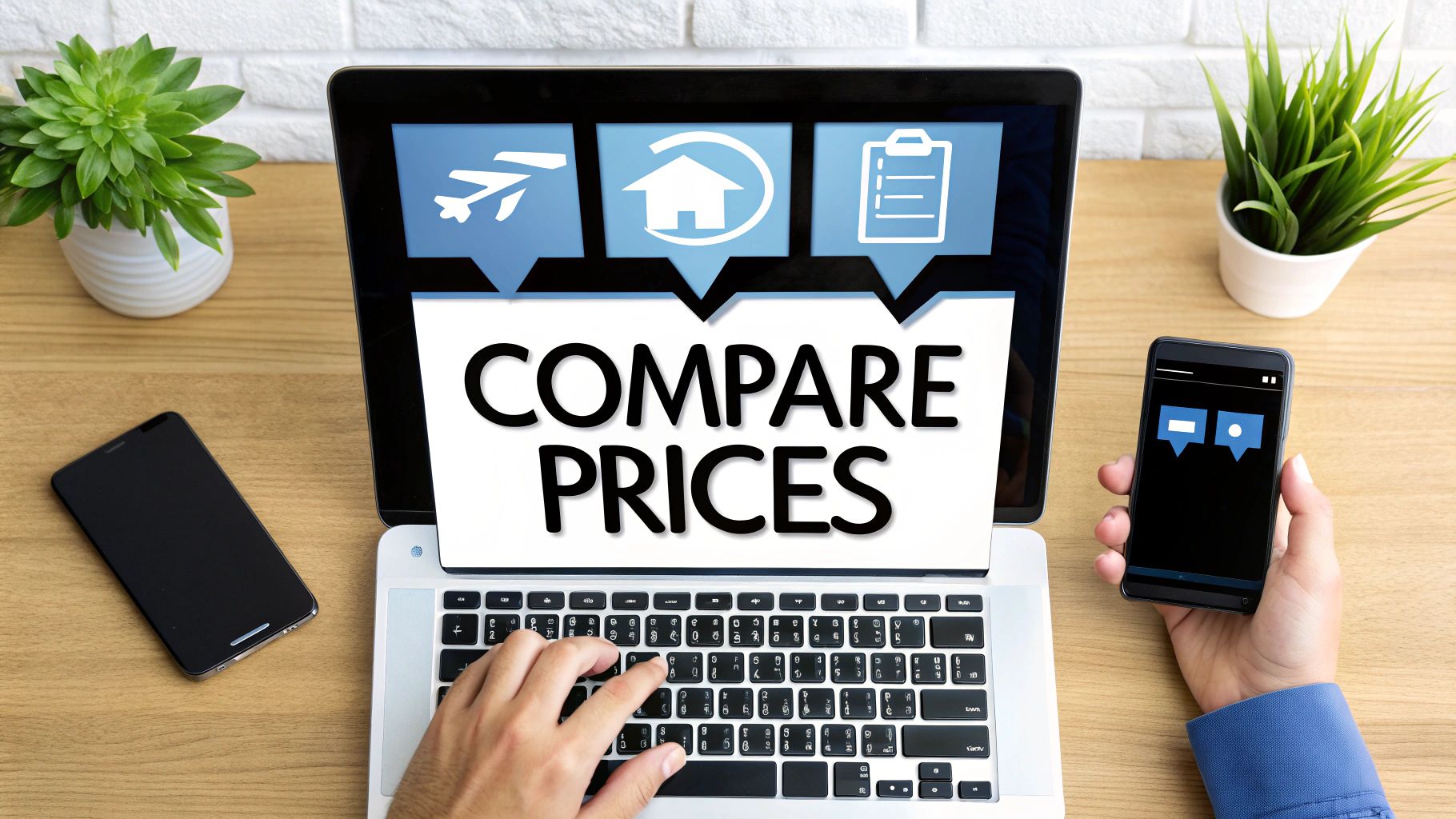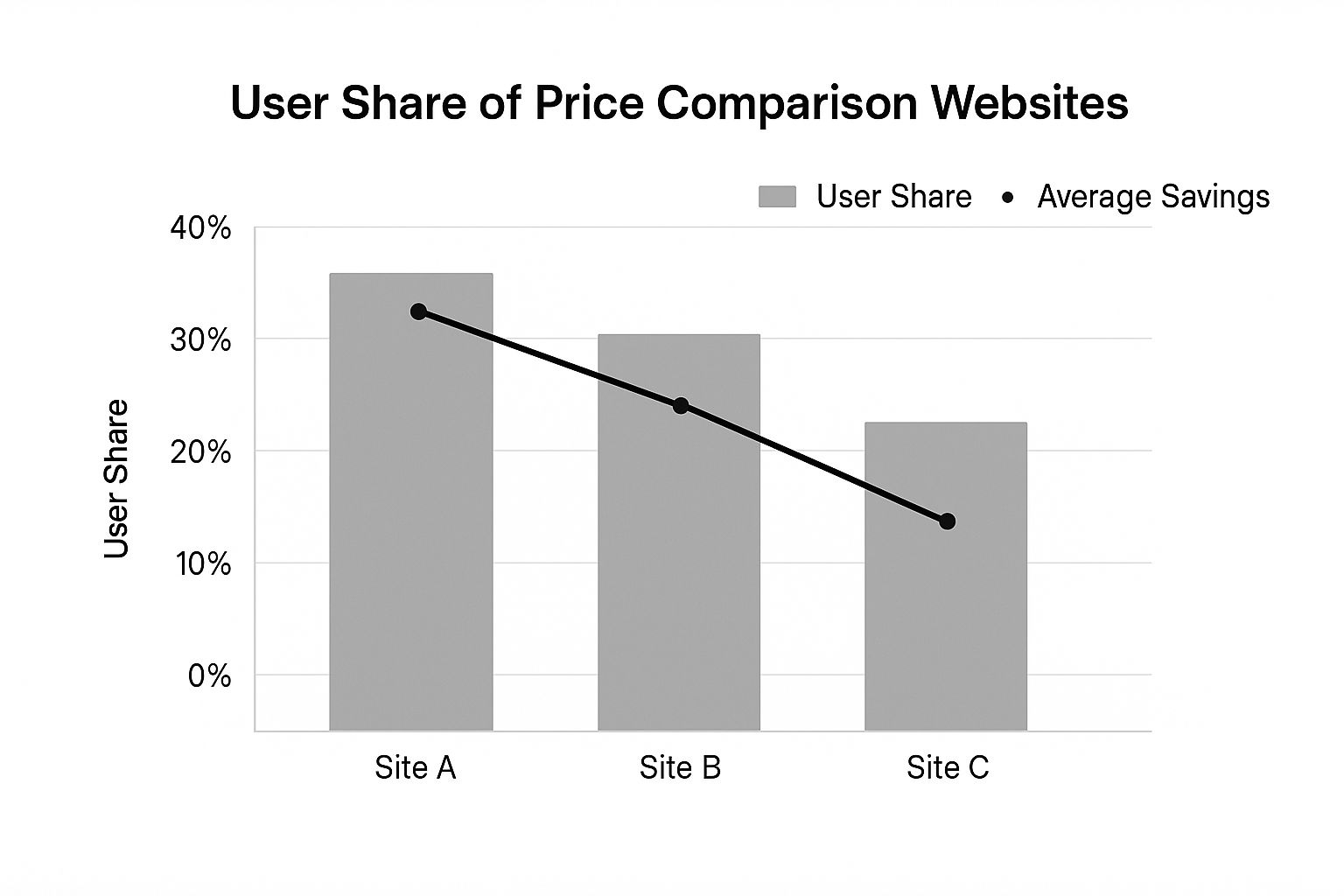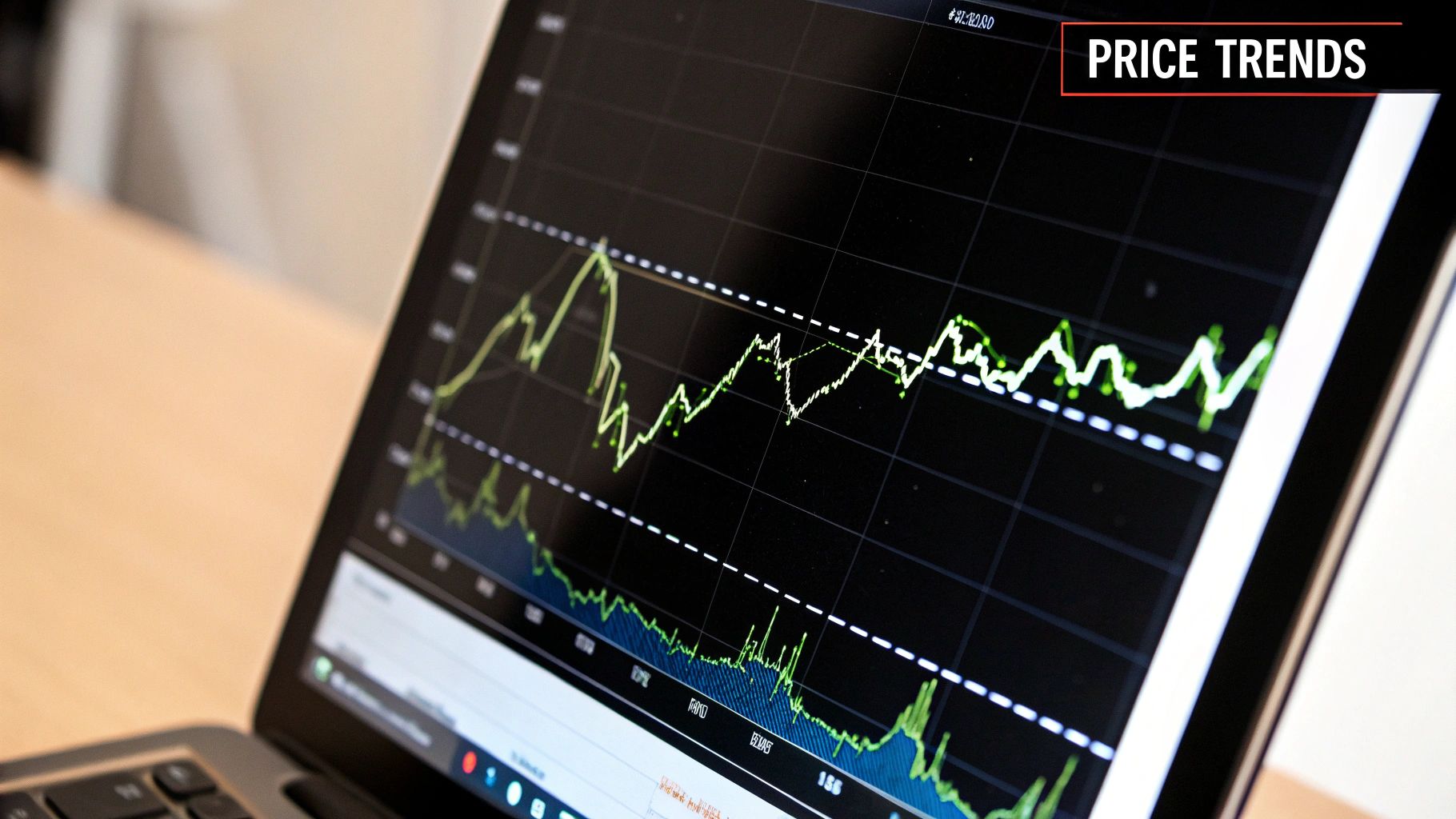
The Evolution of Smart Shopping: Why Price Comparison Matters

Remember the hassle of driving between stores to find the best deal? The digital age has simplified shopping. Comparing prices online is now a vital skill for smart shoppers.
The Power of Price Transparency
Price comparison provides consumers with price transparency. This real-time access to pricing from various retailers gives shoppers significant leverage. It's like having a tool that helps secure the best deal every time. This puts money back into consumers' wallets and encourages retailers to be more competitive.
Imagine searching for a new laptop. Instead of visiting multiple stores, you can compare prices online from home. This saves time and provides a clear understanding of market value, making it easier to find a good deal. This price awareness influences retailer pricing, benefiting consumers.
The Rise of the Informed Consumer
Retailers now contend with the informed consumer. These shoppers are less susceptible to marketing tactics or inflated prices. They prioritize data and value over impulse buys or brand loyalty. This marks a fundamental shift in shopping habits. Global eCommerce sales are expected to hit $6.86 trillion in 2025, an 8.37% increase from 2024. This growth demonstrates the increasing importance of digital platforms for finding competitive prices. Explore ecommerce growth statistics. This highlights the increasing reliance on online price comparisons before purchasing.
The Impact on Your Wallet
Online price comparison significantly impacts personal finances. Consistently comparing prices leads to substantial savings on various purchases, from groceries and electronics to travel and insurance. These savings accumulate, allowing for better budgeting and financial planning. Price comparison is a crucial tool for smart financial management.
Price Comparison Powerhouses: Tools That Deliver Real Savings

The infographic above shows the user share and average savings percentages for the top three price comparison websites: Site A, Site B, and Site C. Site A has the largest user base but offers a lower average savings percentage than Site B. Site B, with fewer users, boasts a higher savings rate. This tells us that popularity isn't everything when it comes to finding the best deals. Site C, while having the smallest user base, provides a competitive average savings percentage, suggesting it may be valuable for shoppers looking beyond the most popular platforms.
Key Features to Consider
When comparing prices online, not all websites are created equal. Certain features can significantly impact your savings. Here are some key functionalities to look for:
- Retailer Coverage: A platform with a broad range of retailers, including both large and small businesses, provides a more comprehensive view of available prices.
- Price History Tracking: This feature allows you to see how prices have changed over time, helping you identify genuine deals and avoid artificially inflated discounts.
- Deal Alerts: Setting up deal alerts for specific products ensures you're notified as soon as prices drop, eliminating the need for constant manual checking.
- User-Friendly Interface: A clean and intuitive interface makes the price comparison process much more efficient and enjoyable.
- Additional Features: Look for platforms that offer extra perks, such as cashback programs or coupon codes, to maximize your savings potential.
Online prices are influenced by various factors, including cart abandonment. Understanding the reasons for cart abandonment and how to address them can be beneficial.
Leveraging Price Comparison Tools Effectively
Using price comparison websites effectively involves more than just visiting a single site. Here are some best practices to ensure you're getting the absolute best deals:
- Compare Across Multiple Platforms: Checking prices on several different platforms guarantees you're not missing out on a better offer elsewhere.
- Read Reviews: Before buying, read product reviews from multiple sources to assess quality and avoid potential issues.
- Factor in Shipping Costs: Remember to include shipping fees and taxes in your price comparisons, as these can substantially affect the total cost.
- Be Mindful of Timing: Prices can change depending on various factors like time of year, day of the week, and even time of day. Strategic timing can lead to significant savings.
The price comparison market is growing rapidly, reflecting the increasing importance of these tools. In 2023, the global market was valued at approximately USD 29.6 Billion. It's projected to reach USD 59.5 billion by 2033, with a CAGR of 7.2%. More statistics on this growth can be found here. This growth clearly demonstrates the impact these platforms have on online purchasing decisions. For more insights, you might find information on How to master... useful.
Choosing the Right Tool for You
The ideal price comparison tool varies depending on individual shopping habits. Some platforms are best for electronics, while others specialize in categories like travel or fashion.
Consider your most frequent purchases and choose a tool that caters to those specific categories. Experimenting with different platforms helps you find the one that delivers the most comprehensive results and offers the best user experience. By using price comparison tools strategically, you can make well-informed decisions and save considerably on your online purchases.
To help you find the right tool, we've compiled a comparison table:
To help you navigate the various options available, we've put together a comparison of leading price comparison websites:
Top Price Comparison Websites by Category:
This table compares the leading price comparison websites across different shopping categories, highlighting their main features and benefits.
| Website | Best For | Number of Retailers | Special Features | User Rating |
|---|---|---|---|---|
| Site A | General Merchandise | 10,000+ | Price Alerts, Cash Back | 4.5/5 |
| Site B | Electronics | 5,000+ | Price History Charts, Expert Reviews | 4.0/5 |
| Site C | Travel | 1,000+ | Package Deals, Price Tracking | 4.2/5 |
| Site D | Fashion | 2,000+ | Coupon Codes, Style Recommendations | 4.7/5 |
| Site E | Groceries | 500+ | Local Store Comparisons, Digital Coupons | 4.3/5 |
This table offers a quick overview of some popular price comparison websites and their strengths. While Site A covers a wide range of products, Site B excels in electronics. Sites C, D, and E cater to more niche markets like travel, fashion, and groceries, respectively. Choosing the best platform for your needs depends on your specific shopping preferences.
Beyond Basic Browsing: Pro-Level Price Comparison Tactics

Let's explore some advanced price comparison tactics that can significantly boost your savings. These strategies are often missed by the average shopper, giving you a real advantage.
Mastering Browser Extensions and Price Trackers
Think of browser extensions and price trackers as your personalized shopping assistants. These helpful tools automatically compare prices across various retailers while you browse. Some extensions display real-time price comparisons directly on product pages, while others alert you to price drops on items you're interested in.
Installing these tools simplifies the comparison process, saving you valuable time and energy. This lets you focus on finding the best product, not just the cheapest price.
Several great browser extensions and price trackers are available. Here are a few popular options:
- Honey: This popular extension automatically applies coupon codes at checkout and provides a helpful price history feature. Honey is a great way to save without any extra effort.
- CamelCamelCamel: Designed specifically for Amazon, CamelCamelCamel lets users track price changes and get alerts for deals. CamelCamelCamel is a must-have for frequent Amazon shoppers.
- Keepa: Similar to CamelCamelCamel, Keepa offers detailed price history charts and deal notifications for Amazon.
Using these tools strategically empowers you to easily monitor price fluctuations and grab the best deals when they appear.
Unleashing the Power of Timing and Loyalty Programs
Smart timing is crucial for maximizing savings. Consider not just what you buy, but when. Prices often change based on seasonal demand, promotions, and even the day of the week. Many retailers offer significant discounts during holiday sales like Black Friday and Cyber Monday.
Loyalty programs and cashback portals can also boost your savings. These programs offer rewards, discounts, and cashback on purchases, reducing your overall expenses. Combining these tactics with price comparison tools creates a powerful combination for stretching your budget.
Calculating the True Cost: Beyond the Sticker Price
Many shoppers focus only on the advertised price. Savvy shoppers, however, understand the importance of calculating the true cost. This means looking beyond the initial price tag and considering other factors:
- Shipping Costs: Shipping fees can differ greatly between retailers and can sometimes cancel out any apparent savings.
- Taxes: Sales tax adds to the total cost and should be included in your comparisons.
- Return Policies: A retailer's return policy is important if the product doesn't meet your needs or requires an exchange.
By factoring in these often-hidden costs, you can avoid surprises and make well-informed purchases. For example, a product might seem cheaper on one website, but higher shipping costs could make it more expensive overall. Understanding the true cost helps you make the smartest choice, ensuring you get the best possible value, even if the initial price isn't the absolute lowest.
The Psychology of Comparison: How 2 People Shop

Understanding how different people approach online price comparison can significantly refine your shopping strategies. This involves recognizing how factors like age, gender, and income influence online buying behavior. Let's explore the interesting world of shopping psychology.
Age and Price Sensitivity
Age plays a key role in price comparison. Younger, tech-savvy shoppers often use price comparison tools and browser extensions. They also frequently compare prices on mobile devices.
Older shoppers may prioritize trusted brands and traditional methods like visiting physical stores or checking flyers. They still compare prices online, but their approach might differ.
The Gender Divide in Online Shopping
Gender also influences habits. Men and women often prioritize different product categories. Men might spend more time comparing electronics or tools, while women might focus on apparel or household goods.
84.3% of men shop online versus 77% of women, each with varying preferences. Men tend towards heavier items like furniture and computers. Women often prefer groceries and clothing. Price comparison significantly influences purchasing decisions. Learn more from these online shopping statistics.
Income and Comparison Behaviors
Income level can affect comparison shopping. Budget-conscious shoppers might meticulously compare prices across multiple platforms. Higher-income individuals might prioritize convenience and speed, potentially paying more for faster shipping or better customer service.
To better understand these trends, let's look at the following table:
Online Shopping Preferences by Demographics
This table presents data on how different demographic groups approach price comparison and online shopping.
| Demographic Group | Online Shopping Rate | Most Compared Categories | Preferred Comparison Method | Price Sensitivity Level |
|---|---|---|---|---|
| Gen Z (18-25) | 92% | Electronics, Fashion | Price comparison websites, mobile apps | High |
| Millennials (26-41) | 88% | Travel, Home Goods | Social media, online reviews | Moderate |
| Gen X (42-57) | 80% | Appliances, Cars | Retailer websites, word-of-mouth | Moderate |
| Baby Boomers (58-76) | 65% | Healthcare, Groceries | Print ads, in-store visits | Low |
This data reveals interesting insights into how different age groups approach online shopping. Younger generations heavily rely on digital tools for price comparison, showing high price sensitivity. Older generations prefer traditional methods and are less influenced by price fluctuations.
Product Category Comparisons
Product type also influences price comparison. Consumers are more likely to compare prices for high-value items like electronics or appliances than groceries. This is due to the potential for greater savings on expensive purchases.
Avoiding the Comparison Traps: What Retailers Don't Want You to Know
Think you're a savvy online shopper? Even the most diligent comparison shoppers can be fooled. This section reveals the psychological tricks and marketing maneuvers some retailers use to encourage you to spend more.
Deceptive Pricing Structures: The Illusion of Savings
One common tactic is the illusion of savings through deceptive pricing. Sometimes, "sale" prices are actually the regular price. Other times, prices are inflated before a "sale" to create a false sense of discount. For example, a retailer might increase a product's price from $50 to $60, then advertise a 20% discount. This brings the price to $48, making it seem like a deal, even though it's only slightly less than the original $50 price.
Shipping Cost Manipulation: Hidden Expenses
Another trap is shipping cost manipulation. A product may appear cheaper on one site, but high shipping costs negate any savings. Always include shipping in your price comparison. Some retailers offer "free shipping" but incorporate the cost into the product price. Compare the final price, including shipping, across different retailers for an accurate comparison. For more tips on finding the best deals, check out our guide on How to Master Product Searches.
Product Specification Sleight-of-Hand: Comparing Apples and Oranges
Retailers can also manipulate product specifications. Two seemingly identical products might have different features or quality levels. This makes online price comparisons difficult, as a lower price could indicate lower quality. Always compare key features, model numbers, and customer reviews before buying. This ensures you're comparing similar products and not sacrificing quality for perceived savings. This is particularly important for electronics, where seemingly small model differences can significantly affect performance.
Cognitive Biases: Anchoring and Decision Fatigue
Retailers often exploit cognitive biases such as anchoring and decision fatigue. Anchoring is our tendency to overemphasize the first piece of information we receive. For instance, a high original price makes a lower "sale" price seem more attractive, even if the "sale" price is still high. Decision fatigue, the mental exhaustion from making too many decisions, can lead to impulsive purchases.
Defensive Strategies: Maintaining Objectivity
To avoid these traps, maintain objectivity. Question advertised discounts, examine product details, and avoid rushing decisions when overwhelmed. Taking breaks during online shopping and comparing prices across multiple retailers prevents hasty purchases. This helps counteract anchoring and decision fatigue, especially for large purchases or during sales events like Black Friday) where the sheer volume of deals can be overwhelming.
The Future of Finding Deals: How Technology Is Transforming Price Comparison
Comparing prices online has become a cornerstone of the savvy shopper's toolkit. But the future of deal-finding is dynamic, propelled by emerging technologies poised to reshape how we compare prices.
Artificial Intelligence: Personalized Price Predictions
Artificial Intelligence (AI) is revolutionizing online price comparison. AI algorithms analyze massive datasets, encompassing your past purchases and browsing history, to provide hyper-personalized price recommendations. This means you'll encounter deals tailored to your specific needs and preferences, saving you valuable time and effort. For instance, if you regularly purchase a specific coffee brand, AI can anticipate upcoming sales and send you a notification. This personalized approach will become increasingly prevalent, offering a more streamlined path to the best deals.
Augmented Reality: Bridging the Gap Between Online and In-Store
Augmented Reality (AR) is dissolving the boundaries between physical and digital shopping experiences. Imagine strolling through a store and using your smartphone to instantly compare prices online. AR apps overlay digital information onto real-world items, displaying product details, reviews, and price comparisons directly on your screen as you browse. This real-time information empowers you to make informed decisions on the spot. Some retailers are already implementing this technology, providing a glimpse into the future of shopping.
Voice Assistants: Your Proactive Shopping Advisors
Voice assistants are evolving beyond simple reminders and music players. They are transforming into proactive shopping advisors, capable of monitoring prices for you. By connecting your shopping lists and preferences to your voice assistant, you can automate the price comparison process. Your assistant can then notify you when a desired product's price drops or becomes available at a lower price from another retailer. This automated monitoring saves you time and ensures you never miss a deal.
Blockchain: Transparency and Verification
Blockchain technology is enhancing transparency and trust in online shopping. Blockchain creates a permanent, tamper-proof record of product prices, simplifying the verification of deals and preventing misleading pricing tactics. This technology has the potential to fundamentally change how we verify pricing information, building greater confidence in online transactions. You might be interested in: How to master navigating the complexities of sitemaps.
Embracing the Future of Savings
These technological advancements are not merely theoretical concepts; they are actively being developed and implemented. By understanding how these technologies are shaping the future of price comparison, you can prepare yourself to capitalize on the opportunities they present. Discover strategies for avoiding comparison traps by reducing operational costs. Staying informed about the latest developments in the field will enable you to save more money and make more informed purchasing choices.
Ready to experience the future of shopping? Visit FindTopTrends today and explore a curated selection of trending products at competitive prices. We offer a diverse range of items, from tech gadgets and fashion accessories to home essentials and travel gear. Our mission is to connect you with high-quality products that enrich your lifestyle, while simplifying price comparison and deal-finding. Start exploring today and see how FindTopTrends can enhance your shopping experience.










